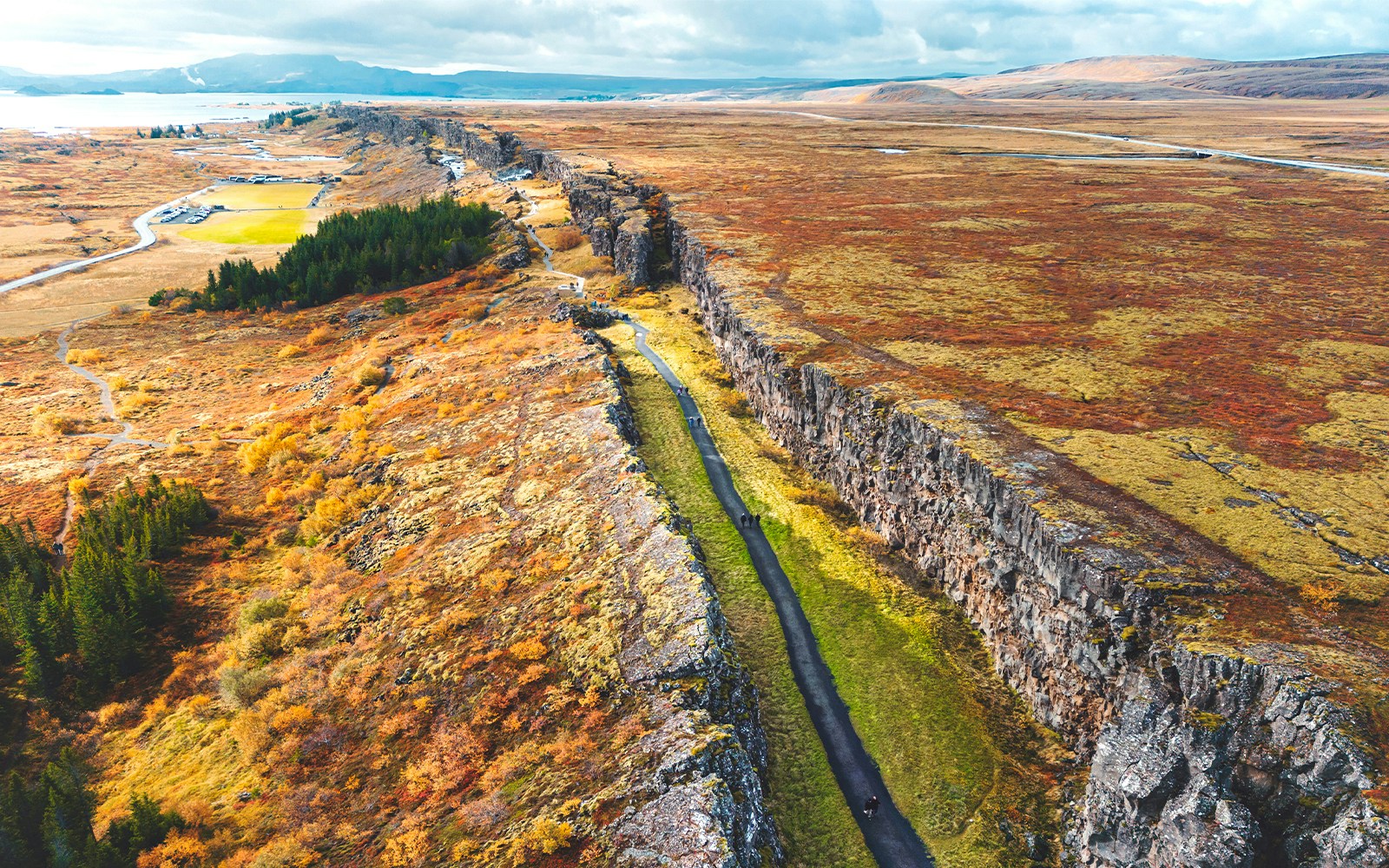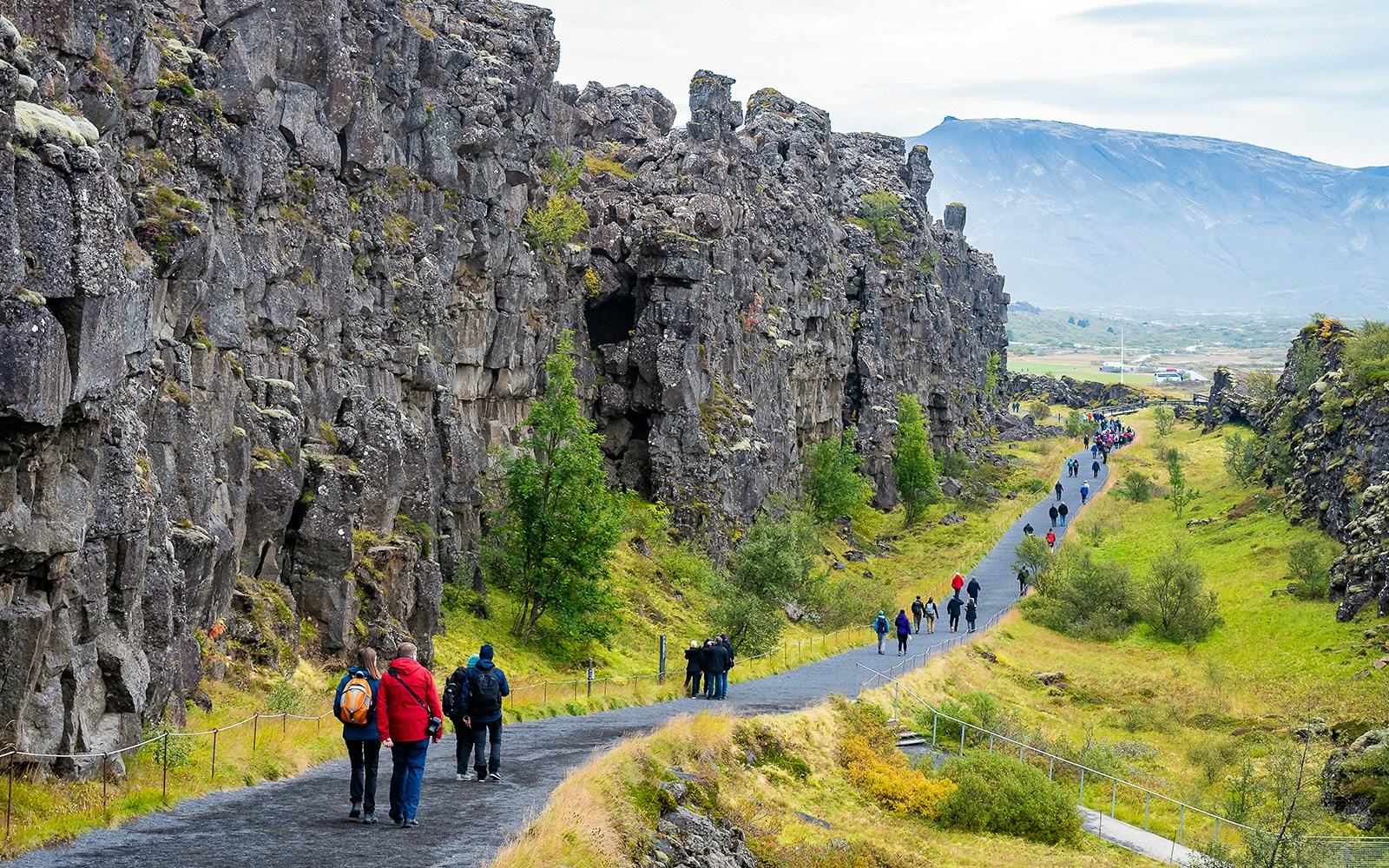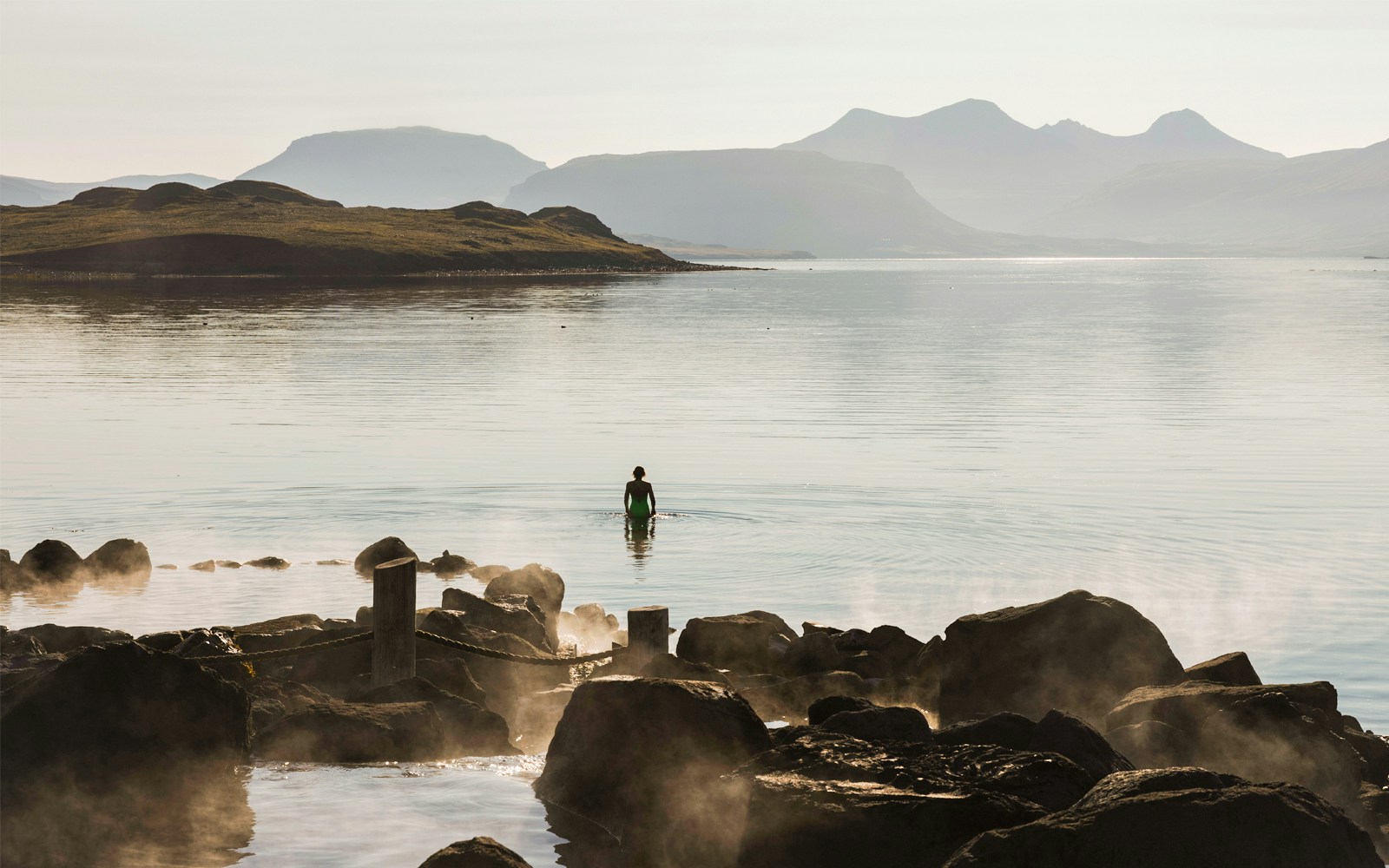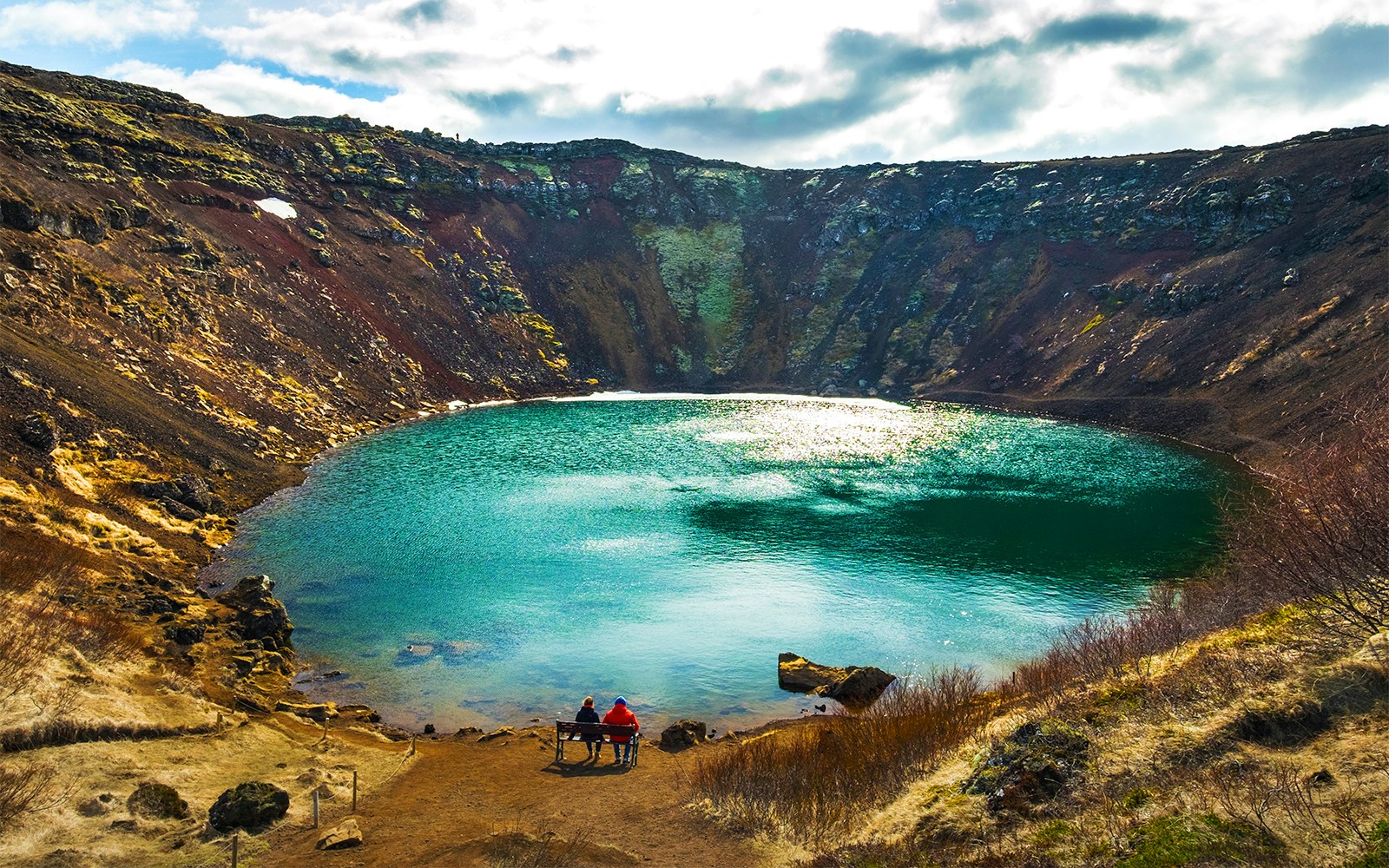Thingvellir is one of those rare places on the planet, where tectonic plate boundaries rise above ground. Here, the North American and Eurasian plates drift apart, shaping dramatic cliffs, rifts, and valleys. It’s like standing at the edge of the Earth’s living history—watching our planet evolve in real-time.
- Blue Lagoon
- Kerid Crater
- Gullfoss Waterfall
- Secret Lagoon
- Northern Lights
- Golden Circle Attractions
- Thingvellir National Park
- Geysir Geothermal Area
- Blue Lagoon Iceland
- Perlan Museum Tickets
- Vok Baths Tickets
- Whale Watching Iceland
- Secret Lagoon Tickets
- Reykjavik Northern Lights Tours
- Iceland Hot Springs
- Jokulsarlon Glacier Lagoon Tours
- Whales of Iceland Museum
- Myvatn Nature Baths
- Hvammsvik Hot Spring
- Sky Lagoon
- Krauma Geothermal Baths
- Glaciers of Iceland
- Langjökull Glacier
Your ultimate guide to Thingvellir National Park | History, activities, & travel tips
Why Thingvellir deserves a spot on your Iceland itinerary?
Witness the power of tectonic plates
Thingvellir National Park attractions you can’t miss

Almannagja Gorge
Step into Almannagja Gorge and find yourself walking between two continents—a rare and humbling experience. This dramatic fissure, formed by the slow drift of the North American and Eurasian tectonic plates, is a striking reminder of the Earth’s restless energy. Its towering cliffs and rugged terrain make it a must-see for nature lovers and geology enthusiasts alike.

Oxararfoss Falls
Tucked within Thingvellir’s rugged landscapes, Oxarárfoss is a hidden gem that enchants visitors with its beauty. The waterfall tumbles gracefully over volcanic rocks, creating a soothing soundtrack as it flows into a serene pool. It’s a perfect spot to pause, take in the view, and capture unforgettable photos.

Logberg Cliff
The Logberg Rock or the Law Rock, is more than just a landmark—it’s a portal to Iceland’s past. Over a thousand years ago, the Althing, the world’s first parliament, convened here. Standing on this historic site, you can almost envision the ancient lawmakers and their passionate debates, a powerful reminder of Iceland’s enduring democratic legacy.

Peningagja Fissure
Peer into the crystal-clear waters of the Peningagja Fissure, where shimmering coins glimmer at the bottom, left by visitors hoping their wishes will come true. Rooted in Icelandic folklore, this tradition is said to bring good fortune, offering a deeper connection to the country’s rich culture and timeless stories.

Silfra Fissure
Silfra is nature’s own infinity pool, an underwater wonderland like no other. Its glacial water is so pure that you can see up to 100 meters, making snorkeling or diving here feel like floating through a dream. Nestled between two tectonic plates, Silfra offers a surreal experience that’s both exhilarating and meditative.

Wooden Church
Nestled within Thingvellir’s landscapes, the Wooden Church invites you to pause and reflect on Iceland’s cultural roots. First built in 1859 and lovingly restored over the years, its simple yet graceful design complements the rolling fields and dramatic lava landscapes.
Thingvellir through the lens: A visual guide








Plan your visit to Thingvellir National Park

- Best time of the year: Spring (April to May) and summer (June to August) offer mild temperatures and long days under the Midnight Sun, making it perfect for hiking and snorkeling in Silfra Fissure. Around September, the park is decked in red and gold hues. The trails are quieter, and the darker evenings offer a chance to see the Northern Lights. Between November and March, Thingvellir turns into a snow-covered wonderland, offering the darkest skies for the best sightings of the Northern Lights.
- Best time of the day: If you want to enjoy a quiet ambiance at Thingvellir, arriving early in the morning is your best bet. With fewer visitors, the park feels serene and almost magical, as if you have it all to yourself. By midday, especially in the summer, the park comes alive with more activity. Popular spots like Almannagja Gorge and Silfra Fissure can get busy.
- Duration of visit: Thingvellir is typically the first stop on your Golden Circle tour. Set aside at least 2 to 3 hours to explore the park’s diverse landscapes, walk along the Almannagja Gorge, and snorkel at Silfra.
Address: 806, Selfoss, Iceland
Find on maps
Distance from Reykjavik: 44.7km (a 41-minute drive away)
If you visit Thingvellir as part of the Golden Circle tour, start from Reykjavik and take Route 1 east to Mosfellsbaer, then turn onto Route 36, which leads directly to the park. The drive offers scenic views of volcanic landscapes and Thingvellir Lake, Iceland’s largest natural lake.
When you arrive, follow the signs to the Thingvellir Visitor Center, where you’ll find parking and easy access to must-see spots like Almannagja Gorge and Oxararfoss Waterfall. After exploring, continue on Route 36 to Geysir and then Gullfoss to your Golden Circle journey. The well-maintained roads ensure a smooth and scenic drive, making this route enjoyable and accessible in every season.

- Trails and pathways: Some of the main trails, like the path through Almannagja Gorge, are relatively flat and thoughtfully designed with benches along the way. However, much of the park features uneven terrain, with sudden drops and fissures that can make navigation challenging for visitors using wheelchairs. If you use a walking aid, we recommend exploring with a caregiver or friend to ensure a safe and enjoyable experience.
- Visitor Center (Gestastofa Hak): The center is designed to accommodate visitors with mobility challenges, featuring accessible entrances and facilities. Here, you can enjoy an award-winning interactive exhibition, ‘The Heart of Iceland’, where engaging displays bring Thingvellir’s rich history and natural wonders to life.
- Parking: You will find accessible parking facilities at several locations, including P1 (Hakio) and P5 (Valholl), offering easy access to the park’s other attractions. If you can provide a valid disabled parking permit, you don’t have to pay any charges. Stop by the Visitor Center to unregister their license plate from the camera system or contact the park via email.
- Restrooms: Accessible restrooms with wide, barrier-free entrances are available throughout the park, ensuring a comfortable experience for visitors with limited mobility.

- Thingvellir Tourist Information Center Cafe (0km away): Serves light snacks, sandwiches, and pastries, offering a quick and simple meal option for park visitors.
- Lindin (18.5km away): Features dishes like pan-fried Arctic char, reindeer carpaccio, and wild goose, made with fresh, local Icelandic ingredients.
- Vinastraeti Veitingahus (19km away): Offers traditional Icelandic dishes, including lamb stew and fish platters, prepared with a comforting, homely touch.
- Restaurant Mika (45.4km away): Renowned for its creamy lobster soup, grilled langoustines, and indulgent homemade chocolates for dessert.
- Frioheimar(45.8km away): Famous for its signature tomato soup served with freshly baked bread, as well as unique tomato-based desserts like green tomato cheesecake.

- Take advantage of the Upper Car parking space: Parking at the upper car park provides immediate access to the Almannagja Gorge, allowing you to walk between tectonic plates within minutes.
- Be selective about your trails: If you are short on time, allocate approximately 1.5 hours to explore key highlights on foot, including the Almannagja Gorge and Oxararfoss Waterfall.
- Keep appropriate winter gear handy: Be prepared for strong winds and icy paths during winter months, especially near viewing platforms and trails. Dress warmly and consider traction aids for footwear.
Top things to do in Thingvellir National Park

Diving
The Silfra fissure inside Thingvellir National Park is the only place on Earth, where you can dive between the North American and Eurasian tectonic plates. The water is so pristine and crystal-clear that you can see nearly 100 meters below as if looking through a pane of glass.

Hiking
Explore the park’s vibrant landscapes on well-marked trails, like the iconic Almannagja Gorge or the scenic paths to Oxarárfoss waterfall. As you hike, you will be treated to stunning views of rugged lava fields, moss-covered rocks, and the shimmering Thingvellir, Iceland’s largest natural lake.

Fishing
The Thingvellir Lake is popular among anglers, renowned for its pristine waters and abundant Arctic char and brown trout. Its serene surroundings and crystal-clear depths create the perfect setting for a rewarding fishing experience, attracting enthusiasts from around the globe.

Camping
Stay overnight at Thingvellir’s designated campsites, which provide basic amenities and an incredible opportunity to sleep under the stars. In the summer, the Midnight Sun adds a magical glow, while in winter, the Northern Lights dance across the sky.
Beyond Thingvellir | Must-see attractions nearby
Laugarvatn Fontana Geothermal Baths
Distance: 18.6km from Thingvellir (a 14-minute drive away)
Situated by the serene shores of Lake Laugarvatn, these thermal baths offer a haven for relaxation. Soak in warm waters or cool off with a refreshing dip in the lake. With panoramic views and a peaceful atmosphere, it’s the ultimate way to unwind and recharge after a day of exploring Thingvellir.
Legends and folklore that bring Thingvellir to life

- The Hidden People of Thingvellir: According to Icelandic folklore, Thingvellir is the secret haven of the ‘huldufolk’, who live quietly among the lava rocks and cliffs. Locals often remind visitors to walk gently and respectfully, as disturbing their homes could bring misfortune.
- The drowning pool: Beneath the serene surface of Drekkingarhylur lies a darker story. In the 17th and 18th centuries, women accused of adultery or infanticide were sentenced to death here, their lives ended in the calm but unforgiving depths. Some believe that the spirits of these women still linger near the pool.
- Silfra’s whispering waters: Nestled between two tectonic plates, Silfra is seen as a liminal space—a bridge between the natural and the supernatural. It’s said that if you dive deep and listen carefully, you might hear the whispers of the Earth or even the voices of Norse gods.
- The trolls of Almannagja: Icelandic tales say these jagged formations were once trolls, frozen in time when caught by the first rays of sunlight. Many believe the spirit of these ancient beings still resides within the rocks.
- Thingvellir Lake’s snake serpent: Iceland’s largest natural lake holds its own enigmatic legend. Locals whisper of a serpent-like creature, hidden in its depths, believed to be as terrifying as Scotland’s Loch Ness Monster.
Book Thingvellir National Park Golden Circle tours
Frequently asked questions about Thingvellir National Park
Thingvellir National Park, a UNESCO World Heritage Site, marks the meeting point of the Eurasian and North American tectonic plates. These plates slowly shift each year, creating stunning rifts and fissures you can walk through. It’s also home to Althing, Iceland’s first parliament, founded in 930 AD, making it a cornerstone of the country’s history.
Thingvellir is about 45km from Reykjavik, a drive of about 45 minutes to an hour. It’s a straightforward trip, often included as the first stop on the Golden Circle route, making it easily accessible for day trips.
Yes, Thingvellir is a key stop on the Golden Circle route, which also features the stunning Gullfoss waterfall and the Geysir geothermal area. You can also pair your Thingvellir visit with other unique experiences like a relaxing soak at the Blue Lagoon, a Northern Lights hunt, or a hike along the Kerid Crater rim.
The best way to get to Thingvellir National Park is to book a Golden Circle guided tour. They include convenient transfers from Reykjavik and offer in-depth commentary about the park’s attractions. If driving, take Route 36 from Reykjavik for a scenic and easy journey.
Thingvellir houses a unique, underwater rift between its North American and Eurasian tectonic plates, popularly known as the Silfra Fissure. With crystal-clear water and visibility extending up to 100 meters, Silfra offers an unparalleled snorkeling experience, allowing you to explore a world unlike any other.
The main visitor center and certain sections of the park are accessible to visitors in wheelchairs. However, due to the natural terrain, not all paths or attractions, like the rift valleys or Silfra, are easily navigable for those with limited mobility.
Yes, you are welcome to bring your own food and drinks to Thingvellir National Park. There are designated picnic areas where you can enjoy your meal while taking in the park’s natural beauty. However, be mindful to clean up after yourself to help preserve the park's pristine environment.














